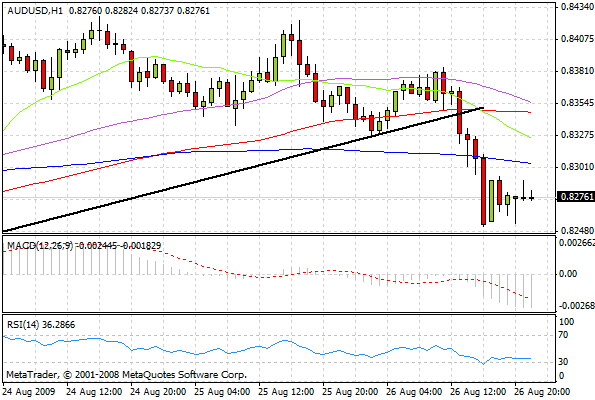Source: ForexYard
Forex trading to today are set to be driven by a batch of data from both the U.S. and Britain. The main release from the U.S. today that traders are waiting for is the Consumer Spending, also known as the Personal Spending report from the U.S. at 12:30 GMT. Forecasts put the figure at roughly 0.2% in July, about half the increase of June. However, the rise is mainly owed to the cash-for-clunkers program. Despite this, a positive figure may actually hurt the USD, as such a result could increase risk appetite. Therefore, in order to take advantage of end-of-week market behavior, open your positions in the USD, EUR, and GBP now.
Economic News
USD – USD Falls Steeply on Thin Trading and Market Optimism
After a period of steady appreciation, the USD took a sharp nose dive at the end of European market hours to close yesterday’s trading at 1.4364 versus the EUR, 1.6284 against the Pound, and 1.0877 against the CAD. The greenback fell due to several reasons that are linked to thin summer trading.
First, with Crude Oil advancing from industrial growth worldwide, the USD is experiencing some downward pressure from commodity purchases. With growth being forecast on the horizon, safety investments like the USD are losing some of their appeal. While the Gross Domestic Product (GDP) of the United States shrank less than expected, many economists are anticipating a rally in US stocks, Crude Oil prices, and riskier investments. These all point to further downward pressure on the Dollar in the days ahead. As such, yesterday’s sharp drop was inevitable.
If today’s figures on Personal Income and Personal Spending in the US confirm the rising trend of growth, the USD could see some added downward pressure. The University of Michigan’s Consumer Sentiment report will also give credibility to these assumptions if it reveals market optimism is on the rise. Traders may anticipate a bearish Dollar if economic news continues to support these latest trends.
EUR – EUR Remains Bullish at End of Month Trading
The EUR’s bullish rally against all major currency pairs continued yesterday with a surprising reversal to the EUR/USD’s recent downtrend coming at the close of European markets. Closing at a surprising 1.4364 against the greenback, the EUR made significant gains on recent boosts to market optimism, risk appetite, and thin market trading. As the month comes to an end, a significant level of position shifting takes place and some trends may see a reversal at the start of September.
Market data from the Euro-Zone and Britain has lately put a positive spin on the 16-nation currency. Germany’s Ifo Business Climate report on Wednesday showed an improvement to investor confidence in the German economy and other data yesterday continued adding momentum. While Britain’s economic figures may also show positive data, the level of confidence in the British banking system, as well as their influx of cash from their quantitative easing program, has put a downward spin on the GBP. This trend may not come to an end anytime soon, but end of month trading usually generates enough volatility to surprise even the most veteran traders.
As for today, the Euro-Zone isn’t scheduled to release any significant reports, but the British government will release its Revised GDP figures showing that Britain’s economy likely shrank by 0.8% last quarter. Switzerland will also publish its KOF Economic Barometer today, measuring the relative strength of the Swiss economy. This report has the potential to add a level of volatility to the CHF not typically experienced in the average trading week.
JPY – JPY Ends August with Batch of Poor Data
Yesterday was a day of bearishness for the Japanese Yen. Losing on all fronts, the JPY finished the day at 134.48 against the EUR, 152.35 versus the GBP, and stable at 93.64 against the Dollar. With the recent surge in market optimism, combined with thin trading at the end of the month, the Japanese Yen has faced surmounting downward pressure as safe-havens are losing their appeal.
Adding to this downward momentum was a batch of negative data releases from Tokyo at the start of Friday’s trading session. Household spending, Japanese CPI, and Japan’s Unemployment Rate all showed worse than expected numbers, with unemployment climbing to 5.7% last month. Closing out the month with such abysmal data definitely does not help the JPY’s strength.
Crude Oil – Crude Oil’s Appeal as Alternative Investment on the Rise
The appeal of Crude Oil investments rose yesterday after the US Dollar weakened on thin trading, growing risk appetite, increasing demand for energy, and end of month investment shifting. As Crude Oil prices rose for the first time in 3 days, investors flocked to the commodity as an alternative investment. Failing to breach the $70 support level, the price of a barrel of Light Sweet Crude subsequently rose back to $72.68 by the end of Thursday’s trading hours.
With global economies beginning to show signs of recovery, and countries such as Australia already on their way to substantial growth, energy prices are expected to pick up in the near future. Likewise, as strength returns to the market, the safety of the US Dollar will fall alongside it, adding further support to Crude Oil prices. A near-term target of $75 a barrel has become a popular goal for many speculators as a result.
Technical News
EUR/USD
The pair soared yesterday by 115 pips to the 1.4356 level. The 4-hour and daily chart’s oscillators seem to be showing misleading signals. However, the RSI of the hourly chart shows the pair above the 70 mark, signaling that a downward reversal is imminent. The MACD of the hourly and weekly charts also support a downward correction for the pair today. Going short with tight stops may turn out to pay off today.
GBP/USD
Despite much Bearishness in this cross this week, the GBP/USD cross went higher yesterday. On the one hand the daily chart’s Stochastic Slow supports this upward correction to continue. However, on the other hand, the RSI and MACD of the hourly chart and the Stochastic Slow of the 4-hour chart supports a bearish reversal for today. Going short with tight stops may bring big profits today.
USD/JPY
The USD/JPY pair has been range trading between the 93.19 and 94.56 levels in the past several days. The Stochastic Slow of the daily chart and RSI of the daily chart support a bullish move for today. However, the MACD of the daily charts supports a possible bearish trend for today. Entering the pair when the signals are clearer seems to be the right choice for traders today.
USD/CHF
The pair went through a dramatic bearish correction yesterday. This was despite rising over the previous several days. The RSI of the weekly chart supports a further drop in the pair for Friday’s trading. This move is also backed up by the MACD of the weekly chart and Stochastic Slow of the daily chart. Entering the popular trend now doesn’t seem to be a bad idea at all.
The Wild Card – Crude Oil
Crude Oil has resurrected yet again as the top bullish commodity in Thursday’s trading. The black gold currently stands at the $72.60 level. Today’s technical data supports another possible upward move for Crude. This is mainly supported by the hourly chart’s Stochastic Slow and 4-hour chart’s MACD. So if you forex traders want to take advantage of this popular commodity now, then enter Crude as soon as possible as end-of-week trading kicks in.
Forex Market Analysis provided by Forex Yard.
© 2006 by FxYard Ltd
Disclaimer: Trading Foreign Exchange carries a high level of risk and may not be suitable for all investors. There is a possibility that you could sustain a loss of all of your investment and therefore you should not invest money that you cannot afford to lose. You should be aware of all the risks associated with Foreign Exchange trading.




